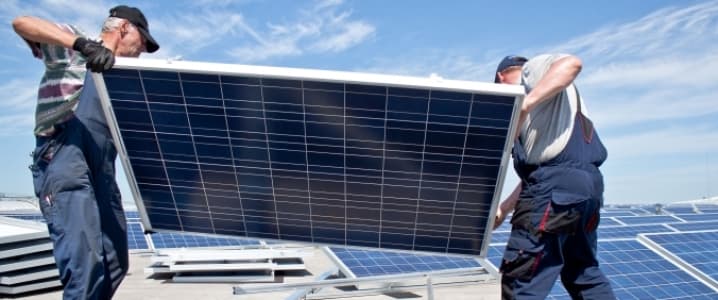
sustainable Energy Prices Hit Record Lows: How Can Utilities profit From buoyant Solar And Wind?
New U.S. Energy Data Administration (EIA) knowledge predict photo voltaic and wind power will dominate America’s new technology in 2020, making up 76% of recent technology and including 42 gigawatts (GW) of zero emission capability, whereas coal and pure fuel will dominate 2020 retirements with 85% of plant closures.
EIA stories U.S. electrical energy technology from renewable power exceeded coal for the primary time in April 2019, and forecasts coal technology will decline 13% in 2020. EIA additionally initiatives pure fuel technology will solely develop 1.3% in 2020 – the slowest price since 2017 – whereas non-hydropower renewable power technology will develop 15% in 2020 – the quickest price in 4 years. New U.S. renewable power funding rose 28% to a report $55.5 billion in 2019 regardless of pro-fossil gasoline Trump administration efforts, U.S. photo voltaic installations may hit a report 19 gigawatts (GW) in 2020 regardless of federal tax incentives phasing out,
and grid regulators estimate 330 GW of wind and photo voltaic will come on-line by 2029. So, is renewable power now unstoppable? If the query is decided by economics, the reply could also be sure. And if renewable power is now unstoppable, what does that imply for the utilities engaged within the energy sector transformation from fossil to scrub power? If the query is decided by sensible utility coverage design, the reply could also be financial alternative.
Renewable power costs fell to report lows in 2019
Lazard’s most up-to-date Levelized Price of Energy (LCOE) evaluation exhibits U.S. renewable power costs continued falling quick in 2019, with wind and photo voltaic hitting new lows, after renewables fell under the price of coal in 2018. LCOE measures the whole price of constructing and working a facility over its lifetime, and exhibits renewables beating fossil fuels by ever-larger margins – even with out subsidies – with that development forecast to proceed for many years to come back. Over the past decade, wind power costs have fallen 70% and photo voltaic photovoltaics have fallen 89% on common, in keeping with Lazard’s 2019 report.
Utility-scale renewable power costs are actually considerably under these for coal and fuel technology, and so they’re lower than half the price of nuclear. The newest numbers once more affirm that constructing new clear power technology is cheaper than working current coal vegetation. In different phrases, it’s now cheaper to avoid wasting the local weather than to destroy it. Capability set up traits mirror this financial actuality, with new wind and photo voltaic technology coming on-line at a breakneck tempo. Wind energy capability within the U.S. has greater than doubled since 2010 and reached almost 100 GW in 2018.
Utility-scale photo voltaic capability grew by an element of greater than 30 over the identical time interval to greater than 60 GW, and is predicted to greater than double over the following 5 years. In Lazard’s LCOE evaluation, unsubsidized wind energy and utility-scale photo voltaic are available in at cheaper price ranges than every other analyzed useful resource together with fuel, coal, and nuclear. Unsubsidized wind ranges from $28–$54 per megawatt hour (MWh), and unsubsidized utility-scale photo voltaic ranges from $32–$42/MWh. Factoring in subsidies, wind costs plunge to $11–$45/MWh and utility-scale photo voltaic costs keep comparatively secure at $31–$40/MWh. Unsubsidized clear power ranges are decrease than nuclear at $118–$192/MWh, coal at $66–$152/MWh and fuel mixed cycle at $44–$68/MWh. Even contemplating these figures apply solely to new technology capability, wanting on the marginal prices to run current coal or nuclear—$26–$41/MWh and $27–$31/MWh respectively, exhibits constructing new renewable power stays aggressive with working current technology.
As renewable power costs preserve falling, states set increased set up targets
Renewable power costs are anticipated to proceed declining, with costs falling even farther over the following three many years, in keeping with the Nationwide Renewable Energy Laboratory’s (NREL) 2019 Annual Know-how Baseline. NREL predicts the LCOE of wind applied sciences will decline no less than one other 64% by 2050 in its optimistic situation and no less than 44% in its mid-level situation. In those self same eventualities, photo voltaic’s LCOE falls by 74% and 47% by 2050.
Fossil gasoline proponents usually level out that specializing in LCOE doesn’t account for grid reliability considerations or monetary legal responsibility imposed by closing coal vegetation forward of schedule. That’s true—nevertheless it’s additionally true that LCOE doesn’t account for the local weather change dangers and well being prices of constant to pour carbon dioxide and different greenhouse gases into the air. Thirty-seven states have acknowledged these full results, conceptually if not explicitly, by way of renewable portfolio requirements or renewable portfolio targets that variety their electrical energy provide and promote financial growth. A rising variety of jurisdictions have set much more formidable targets as costs have fallen with 11 states, Puerto Rico, and the District of Columbia dedicated to 100% clear electrical energy.
The underside line: Renewables are actually cheaper than the common price to function coal and common price to construct new pure fuel. Plunging clear power costs have been made attainable by each R&D and the financial “learning curve” idea: As extra of a expertise is deployed, it turns into cheaper and extra environment friendly. Add all of it up, and this development isn’t going away anytime quickly. Utilities can capitalize on this development whereas lowering emissions, however coverage serving to handle the monetary transition is vital to encouraging a easy and fast transition.
Alternatives for utilities with the best coverage help
Some utilities have embraced the transition to scrub power, whereas others are nonetheless working uneconomic coal vegetation and constructing new pure fuel. However as power economics and state targets shift from fossil gasoline to scrub power, the utilities that keep on with a business-as-usual method achieve this at their very own peril, growing the chance of high-priced stranded belongings and better shopper electrical energy costs. As a substitute, utilities may exchange fossil gasoline vegetation with new renewables in a “steel for fuel” method, growing fairness earnings by shifting capital from uneconomic fossil energy vegetation counting on vital gasoline expenditures to vegetation that run on free gasoline – photo voltaic and wind.
The working price financial savings of this method might be substantial, turning unproductive capital into productive, clear producing belongings. To additional speed up this transition, regulators can concentrate on complementary insurance policies in wholesale energy markets that place these low cost and clear technology sources on an equal footing with conventional fossil sources.
Wholesale energy markets had been designed round a system the place massive centralized vegetation provided rigid shopper demand, however that paradigm is shifting as carbon-free sources displace fossil gasoline technology. Wholesale market reform will help utilities reap the benefits of ample low cost and clear sources by together with technology-neutral, market-based procurement together with performance-based regulation, which shifts utility focus away from capital funding towards delivering worth for purchasers. Lastly, regulators and utilities ought to promote demand response, enhance transmission capability, and improve distribution infrastructure, amongst different complementary electrical energy insurance policies, to accommodate the inflow of renewables.
In Colorado, for instance, efficient utility regulation has pushed a surge of low-cost bids for wind and photo voltaic initiatives. And in Hawaii, the authorized separation of income from capital expenditures is an instance of performance-based regulation that can assist the state obtain its 100% renewable power goal.
Renewable power’s financial alternative is just too huge to go up
As renewable power costs preserve falling whereas clear power targets preserve rising, policymakers should contemplate forward-looking utility and energy market rules to achieve their decarbonization targets whereas serving to utilities capitalize on the clear power transition. With costs for wind and photo voltaic at all-time lows, the chance is just too huge to go up.




